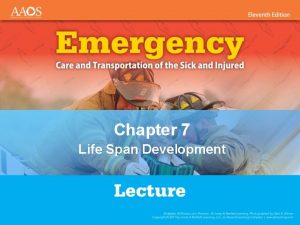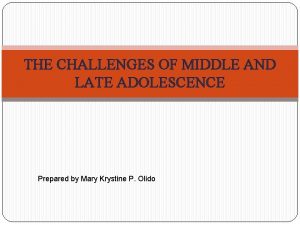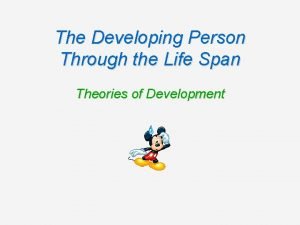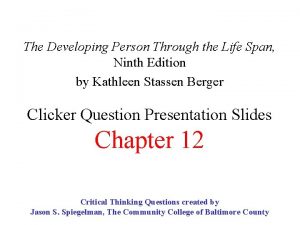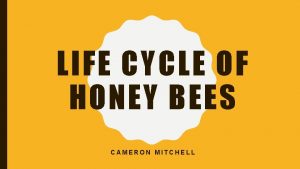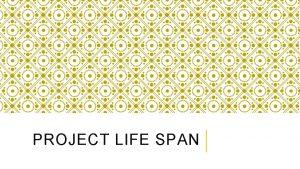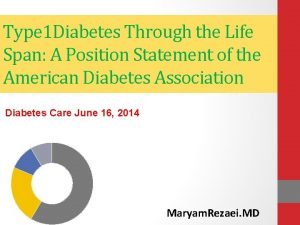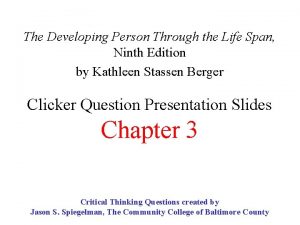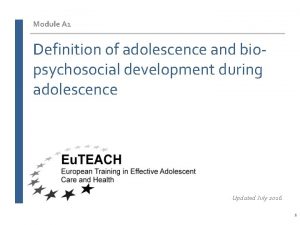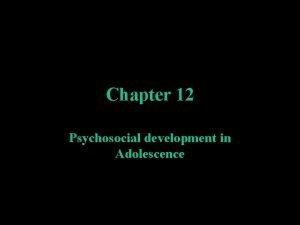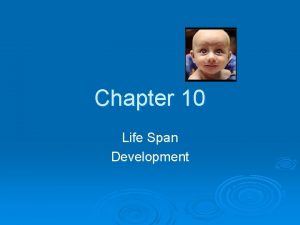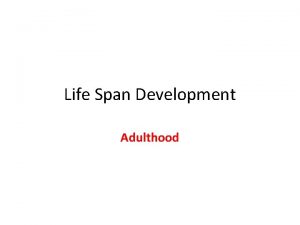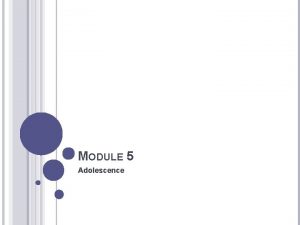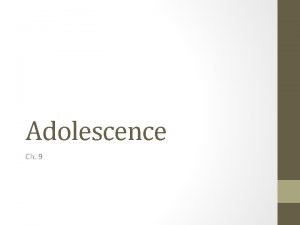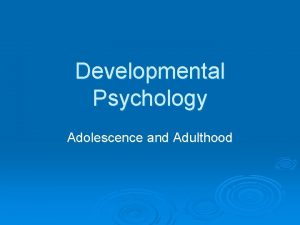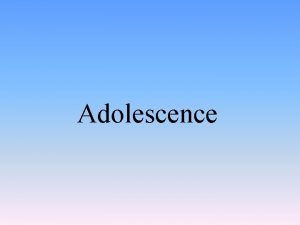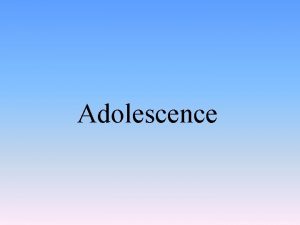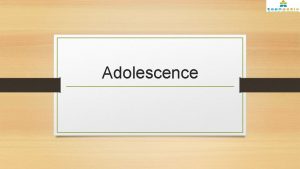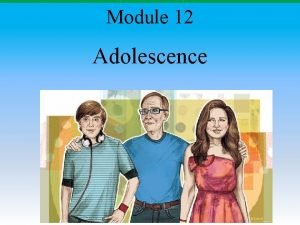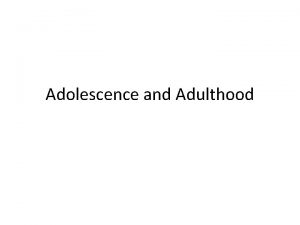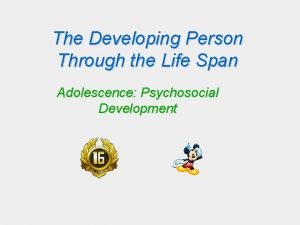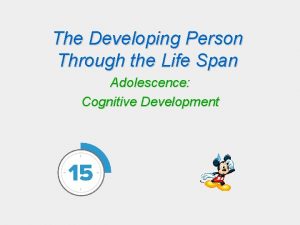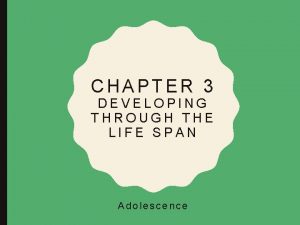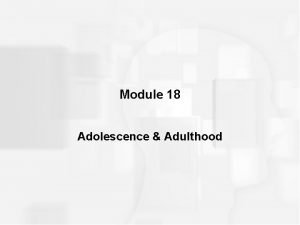Module 5 Adolescence Life Span Development Adolescence Think


















- Slides: 18

Module 5: Adolescence Life Span Development

Adolescence • Think of the person you were when puberty hit… are you the same person now? – What has changed? – What celebrations did you have when this happened? • No longer a child, yet not an adult. • This is probably the most dramatic change you will ever face!

Adolescence back in the day… • 13 – adult celebration • Next – marriage! – Female – child-rearing and domestic work. – Male – hunter • In early 1800’s… – 8 th grade was the end of education, must work! – Many married with children before 20 years!

Adolescence today • Adolescence: – Period between childhood and adulthood. • Adult status is reached later these days. – Longer to finish school, get married, have kids. – Many want to stay financially dependent on parents for longer. – Begins with sexual maturation. • Now happens about 2 years earlier. • Creates tension because part of them is adult and part isn’t…let’s discuss this! – Teen pregnancy for example.

Sound familiar? • When you want to be an adult, the message can be to be patient and wait…when you want to act childlike, you hear that you should grow up and act your age. • Parents aren’t ready to let you have independence. • What are other common themes of this time of life?

Physical changes during adolescence • Puberty: – Time when a person matures sexually. – Hormones that bring on physical and emotional changes start this stage. – Girls about 11, boys about 13 years old. • What puberty brings: – Growth spurts • Early middle school girls can be taller, but around 8 th/9 th… boys outgrow females. – Primary sex characteristics: • Reproductive organs. • See chart – pg. 83 – Secondary sex characteristics: • Breast development, facial hair…less related to reproduction.

Adolescent development • Obvious signs of puberty: – Menstruation for girls and beginning of ejaculation for boys. • Sexuality has cognitive and cultural factors. – Music, media, movies, internet, etc. – Safe sex vs. abstinence • Sexual orientation: – One’s attraction toward people of a particular gender. • 3 -4% of males, & 1 -2% of females are exclusively homosexual. • 1% bisexual. • What determines sexual orientation? – Nature or nurture? – Choice or no?

Adolescent Reasoning • At the beginning of this time, Jean Piaget says we are at the formal operational stage. – When we develop adult thinking and reasoning. • Formal logic & abstract thinking are possible and this represents a qualitative change. – Don’t think more… you think differently. • Doesn’t happen all the time, at this stage you tend to think more of yourself than anything else. – Falling in love for the 1 st time, breaking up, etc. • Can focus on idealistic thinking, and can totally devote yourself to a cause quite passionately.

Lawrence Kohlberg: morality • Morality: – One’s sense of right and wrong. • Kohlberg felt our way of thinking about moral situations changes with our level of development.

He posed moral dilemmas to participants in experiments: • Page 86. • Wasn’t interested in whether the person thought Heinz was right or wrong. • Instead, what reasoning did people use to make their decisions? • Came up with three levels of moral development: – Preconventional moral reasoning (concern with self), conventional moral reasoning (concern with fitting in), and postconventional moral reasoning (concern with broader ethical issues).

Kohlberg’s Levels of Moral Reasoning Draw this chart~!!!

Another way to see it… • Pre-conventional: – Student working on an assignment, “I better do well on this worksheet, or the teacher will be mad at me. ” • Conventional level: – Working on a book report, “I hope I do as well as everyone else in the class so I don’t stand out. ” • Post-conventional: – Teacher reading a book, “my new approach to distributing food could end hunger in the world. ”

Criticism to Kohlberg • Postconventional stage – not supported. – Stage mostly occurs in white male population. • Groups that value individualism. – Think for yourself, stand on your own two feet! • In communal cultures, the notion that postcoventional morality is superior to conventional morality receives little support. – North American women are more communal and do not agree!

Social Development in Adolescence: Erikson • Theory of social development. • Certain issues peak during different periods of life, including adolescence. • Life span divided into 8 stages from infancy to late adulthood. – Each stage has a psychosocial development task. • Challenge, how individuals handle the task will lead to a more desirable or less desirable outcome.

Erikson's Stages of Psychosocial Development • See, know, love handout! • Primary task of adolescence according to Erikson is…. ? – A strong, consistent sense of who and what you are! • How do we search for our identity? – Experimentation • Healthy and not – Career, drugs, etc. – Rebellion • Same values as rents? • Self-destructive? – “Self”-ishness • Different cliques – Teen friendships temporary? – Life long friends, later in life. – Optimism & Energy • Good outlook • Don’t tolerate things (pollution, civil rights)

Erikson – Developing Intimacy • Says you strive to achieve intimacy: – A close, sharing, emotional, and honest relationship with others. • Spouses, friends, family members. – Doesn’t have to be sexual! • Intimacy vs. Isolation: – “Baggage” – Can’t share yourself honestly and openly if you are confused about your sense of self. Independence From the family • Speeds up in this stage. – Primary attachment to parents shifts to peers. • Mall example. • See page 92.

3 Key Development Issues • 1. ) Continuity and Stages – Are we tadpoles turning into frogs? – Are we saplings growing into trees? – Cognitive development – Moral development – Social development – Adolescence relies on continuity and stages.

3 Key Development Issues • 2. ) Stability and Change – Tempermant and values…stay constant. – Relationships and certain behaviors… change. • 3. ) Nature and Nurture – Nature – important with sexual feelings and interests. – Nurture – also learn about expressing sexuality from families and society.
 Think big think fast
Think big think fast Chapter 7 life span development
Chapter 7 life span development Challenges middle and late adolescence
Challenges middle and late adolescence Facts about butterflies
Facts about butterflies Turritopsis nutricula immortal
Turritopsis nutricula immortal Eagle plucks out beak and talons
Eagle plucks out beak and talons Life span theories
Life span theories Carly is given grapes and strawberries
Carly is given grapes and strawberries Life cycle of a honey bee
Life cycle of a honey bee Petit four glace
Petit four glace Project life span
Project life span The developing person through the life span 9th edition
The developing person through the life span 9th edition P.b.shelly
P.b.shelly Life span type 1 diabetes
Life span type 1 diabetes The developing person through the life span 9th edition
The developing person through the life span 9th edition Health model
Health model Moral development in adolescence
Moral development in adolescence Late adolescence
Late adolescence Psychosocial development in adolescence
Psychosocial development in adolescence

